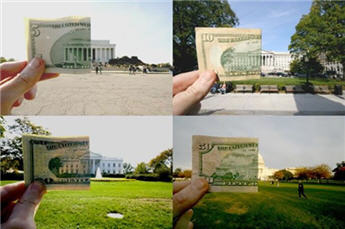Another Yo-Yo Day For Stock Markets
Stock-Markets / Financial Markets 2009 May 13, 2009 - 04:12 AM GMTBy: PaddyPowerTrader
 A lacklustre, see-saw day of modest gains for the blue chip Dow, while the Nasdaq felt some pain. A near term sell-off back to the mid-low 800s for the S&P 500 is still very much on my mind, but while this is very tradable, I do not think that it is the start of a big sell-off to fresh lows; that will come when the data turns and there are no signs of that yet. This, I feel, is about a month away.
A lacklustre, see-saw day of modest gains for the blue chip Dow, while the Nasdaq felt some pain. A near term sell-off back to the mid-low 800s for the S&P 500 is still very much on my mind, but while this is very tradable, I do not think that it is the start of a big sell-off to fresh lows; that will come when the data turns and there are no signs of that yet. This, I feel, is about a month away.
Today’s Market Moving Stories
- The U.S. dollar fell to a four-month low on Wednesday, as optimism about a global recovery and concerns about U.S. fiscal health reduced its safe haven appeal, while oil held near $60 a barrel on hopes for more energy demand as inventories tighten.
- Japan’s opposition party says it would refuse to buy American government bonds denominated in US dollars, if elected. EUR/USD is testing recent highs on this news reaching 1.3720 overnight.
- The FT suggests Germany will today announce a ‘bad bank’ plan to remove toxic assets from bank balance sheets. The paper also carries a story suggesting the US is at risk of losing its AAA status.
- Unidentified Fed officials tell Bloomberg that the Fed views the increase in Treasury yields as a sign of the better economic outlook rather than an indication it needs to step up purchases, adding that the goal is to stimulate private lending rather than targeting government bond yields. I think this is a very dangerous laissez faire strategy that could seriously backfire.
- Other press report that a bi-partisan group of lawmakers in the US will revive a bill that could raise tariffs on Chinese goods, in order to punish the country for currency manipulation. This is unlikely to become law, but highlights the fact that protectionist risks persist.
- It seems that China are gobbling up the black stuff again in huge quantities.
- The median price of a home fell 14% in the first quarter, the National Association of Realtors says. The national median price of a single-family home fell to $169,000 in the first quarter from a year ago. That was a bigger decline than the fourth quarter of 2008, when the median price fell 6.2%. Moreover, the report said, prices fell in 134 of the 152 metropolitan areas the NAR surveys cover, which is about nine out of 10 U.S. cities.
- General Motors shares slump to a 76-year low on bankruptcy worries. Six GM executives revealed after the bell on Monday that they dumped direct holdings in the company, shedding $315,000 in common stock. And it that wasn’t enough woe for the stock, it also seems to be is inching its way off the Dow. The head of the index’s oversight committee said it was looking increasingly likely that GM would be replaced. “The chain of events involving GM and Citi seem to be marching in a certain direction,” said John Prestbo, executive director of Dow Jones Indexes and the chairman of the DJI oversight committee.
- Tech stocks may get a boost on Wednesday from Intel Paul Ottolini, who told investors today that the chip giant’s business in the second quarter was “a little better than expected.”Intel did not offer a formal outlook for the second quarter, but said it expects revenue to be roughly flat to the first quarter. The shares were up 3.8% after hours to $15.79, after they had fallen 1% to $15.21 in regular trading.
- Kerry Group has reaffirmed it guidance at 160-65 EPS. A strong uplift in trading margins, driven by efficiency measures and lower raw material costs, is allowing Kerry to remain on track for full-year guidance despite what remain tough trading conditions. The key messages from the IMS statement are that sales momentum is improving in ingredients after a slow start to 2009 and that the like-for-like (lfl) sales decline in consumer foods is being offset by the margin uplift.
- Elan has appointed Richard D. Pilnik as a non-executive director, adding commercial and marketing experience to both the Board and specifically to the Commercial Committee of the Board. The latter is tasked with supporting Elan’s ambition to maximise its commercial opportunities in Tysabri and its late-stage development pipeline. Pilnik served at Eli Lilly for 25 years.
- A financial psalm.
- Reasons to be fearful! Look who has turned bullish…
Potential Policy Hot-Potatoes
 Main overnight story is on Bloomberg, which quotes John Taylor (the former Fed official who devised the rate-setting Taylor Rule) as saying the Fed will need to raise rates soon to combat future inflation caused by the recent stimuli. Though, of course, the timing of any exit strategy from the policy of ZIRP & QE is going to be tricky, this is the kind of black swan policy mistake that could totally derail any recovery methinks.
Main overnight story is on Bloomberg, which quotes John Taylor (the former Fed official who devised the rate-setting Taylor Rule) as saying the Fed will need to raise rates soon to combat future inflation caused by the recent stimuli. Though, of course, the timing of any exit strategy from the policy of ZIRP & QE is going to be tricky, this is the kind of black swan policy mistake that could totally derail any recovery methinks.
Sticking with financial policies, Finance minister Brian Lenihan is setting off for a tour in Europe. He’ll aiming to explain how the Irish bad bank, the National Asset Management Agency (NAMA), will operate. The FT writes that minister’s main task will be to convince sceptics the agency will be free of favouritism and political interference.
Ireland has just gone through 10 years of judicial tribunals that exposed a culture of corruption in planning and development. People are worried that developers may use Nama to walk away from their debts, leaving the taxpayer to pick up the tab. It is vital for Nama to demonstrate its independence and its capacity to manage and protect taxpayers’ money.
So What’s My problem With Stock Valuations?
While the world may be less nervous than it was, it’s important not to forget that the world is still in recession and profits are still going down, not up. It’s a well-worn truism, of course, that stock markets move ahead of the real economy, but it’s unclear to us whether we’ll see either a huge rebound in growth or, at some point, a sustainable surge in corporate profits. And all that is hugely important, because a world that has been stabilized but is merely limping along and where profits are far harder to come by is a world in which equities are likely to struggle over the longer term.
Why aren’t equities a screaming buy? Well, one reason of course is that multiples aren’t, in fact, that low by historical standards, because profits have fallen so much. The S&P’s trailing PE, even on operating profits, is a hardly low 18x. On an as-reported basis, it’s, ahem, 62x. Ah, comes the reply, but multiples rise in advance of a recovery and having been hammered so much, profits should rebound strongly since costs have been cut so much. Multiples, then, will be a lot more comfortable.
One way to strip this effect out is to compare current equity prices with ten-year average profits, à la Graham and Dodd, since this will tend to fall even though, as is the case now, the trailing multiple rises very strongly indeed. To put this a slightly different way, a G&D type methodology allows you to strip out the effects of the economic cycle on corporate profits. But even this doesn’t make equities very cheap.
As we’ve said before, the S&P 500 valuation has often bottomed on a G&D valuation of 10x, and in the early 1930s it bottomed at 5x. It’s now 18x. So stocks are a lot cheaper than they were, but not even by the wildest stretch could they be called arrestingly cheap.
There are 2 central flaws in most equity valuation models at the moment.
Firstly, they are distorted by the risk-free rate which they use i.e., the 10 year government bond yield rate being so historically low. Secondly, they assume that the developed world will return to its medium term “trend” growth rate relatively seamlessly when, as was the case with Japan in the 1990’s, the potential rate of growth actually may have declined. This may well now happen again due to huge fiscal deficits, higher taxes, increased household and corporate saving and greater government intervention in the financial system. Recall that the Nikkei is still 70% below its 1989 level.
The Day Ahead
US import prices, Apr (12:30 GMT): Prices should be up 0.6%, which is another modest gain after prices collapsed late last year.
US retail sales, Apr (12:30 GMT): March sales were disappointing after healthy reports for January and February. Sales should dip by 0.1% in April, up 0.1% excluding motor vehicles.
And Finally, “Oh Obama”
Disclosures = None
By The Mole
PaddyPowerTrader.com
The Mole is a man in the know. I don’t trade for a living, but instead work for a well-known Irish institution, heading a desk that regularly trades over €100 million a day. I aim to provide top quality, up-to-date and relevant market news and data, so that traders can make more informed decisions”.
© 2009 Copyright PaddyPowerTrader - All Rights Reserved
Disclaimer: The above is a matter of opinion provided for general information purposes only and is not intended as investment advice. Information and analysis above are derived from sources and utilising methods believed to be reliable, but we cannot accept responsibility for any losses you may incur as a result of this analysis. Individuals should consult with their personal financial advisors.
PaddyPowerTrader Archive |
© 2005-2022 http://www.MarketOracle.co.uk - The Market Oracle is a FREE Daily Financial Markets Analysis & Forecasting online publication.




